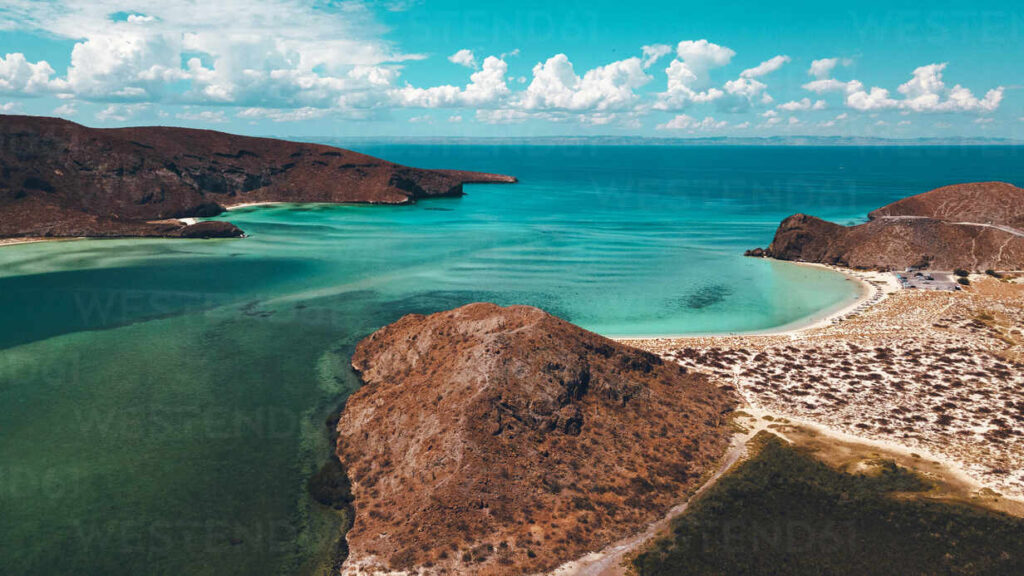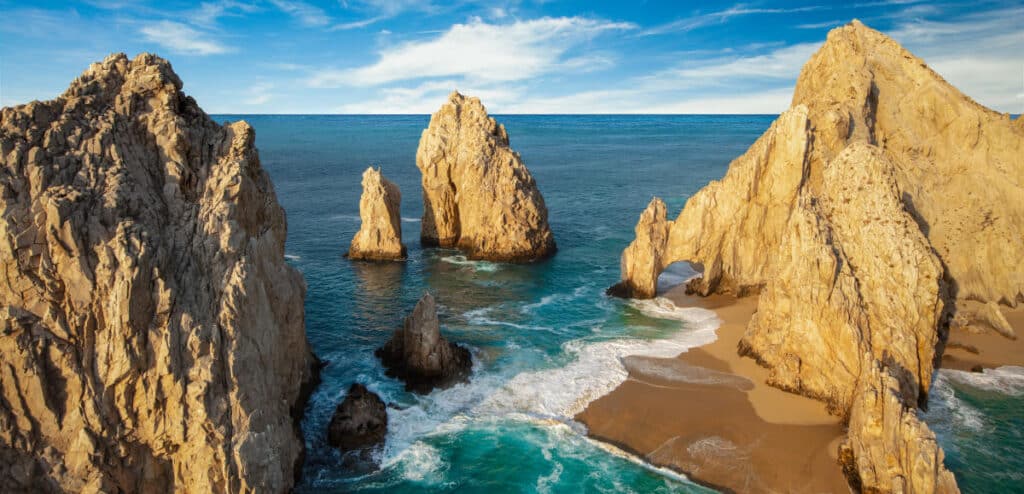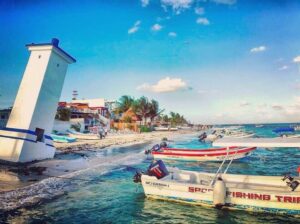Diving in Cabo San Lucas Marine Park
Cabo San Lucas Scuba-Diving
The 4 best dive sites
The famous Jacques-Yves Cousteau referred to Cabo San Lucas as “the aquarium of the world.” Located between the Sea of Cortez and the Pacific Ocean, the lovely climates and conditions of these two powerful bodies of water make diving Cabo San Lucas truly amazing.
Today, Cabo proudly holds the No. 2 spot on Mexico’s list of top travel world destinations, second only to Cancun. The scuba community has long known about Cabo’s delights, and the region offers dive sites suitable for all levels. The climate is tropical desert, with hot and humid summers and fall months. Slightly cooler, crisper temperatures follow for the rest of the year.
Table of Contents
Diving in Cabo San Lucas Marine Park - The 4 best dive sites
The 4 best dive sites
Although you can easilly reach many dive sites from shore, diving by boat is most common. There are several local dive shops, all downtown on the main marina. Once you book, you will meet your divemaster at their divecenter, then meet the crew and head down to the boat. If you’re diving in Cabo San Lucas (CSL) Marine Park, you’ll take 10-minute boat ride before you reach one of the various dive sites. Here are the 4 best dive sites in Cabo San Lucas.
Pelican Rock
This novice-to-advanced site is located on the west side of the CSL Marine Park. Divers will immediately notice a large rock approximately 91 m offshore. As the most accessible dive site, popular Pelican Rock sees hundreds of tourists daily. The rock is surrounded by sand at a depth of 6 m, but if you keep going north side of the rock, a beautiful reef appears. It continues until it meets the main wall at a depth of 24 to 30 m, where it dives into a submarine canyon, hundreds of meters deep.
You’ll get the opportunity to see a wide variety of schooling fish here, including snappers, jacks, Moorish idols and even a group of whitetip reef sharks that move in during the summer months. Pelican Rock is also home to the famous sand falls, where you can watch as sand from the shelf plunges over a ledge into the abyss, like an underwater waterfall.
North Wall
North Wall is the closest site to the Cabo San Lucas Marina, which also means it’s the most protected dive site of those within the Marine Park. The site begins on a sandy slope in 3 m of water and slopes down to the start of a rocky wall at 7 m. The wall consists of primarily small- to medium-sized boulders, creating endless hiding places for animals such as banded guitarfish, scorpionfish, moray eels, and whitetip reef sharks.
Land´s end
Land’s End is good for all diver levels and includes both a seal colony and a wreck. The sea lions are accustomed to share their underwater world with divers and often come in close, blowing bubbles and seeing what the tourists are doing. As you make your way toward Land’s End from the colony, you will find a large pinnacle, barely breaching the surface, which extends down to the seafloor at 22 m.
If you’re beginning the dive from the Pacific side of Land’s End, you will go down directly over the remains of an unnamed shipwreck, uncovered several years ago during Hurricane Odile and now scattered across an area the size of a football field. This is one of those bucket list sites that all divers should experience, as you never know what you’ll find. Schooling fish, sea lions, mobula rays — maybe even humpback whales.
Neptune´s finger
Locating Neptune’s Finger is easy — just look for the large spire jutting out of the water to the East of Lover’s Beach and drop anchor in front. There is a sand flat at 5 m, which leads down to several large, rocky outcroppings ranging from 12 to 30 m down.
Here, sandy bottom meets a sheer wall dropping down hundreds of meters. Typically known as an advanced dive site, divers in the know will spend up to half their dive out in the blue away from the wall, hoping for a magical pelagic encounter. Neptune’s Finger often features large pelagics, such as mobula rays, sea turtles, tuna and occasionally whale sharks.
Marine life in Cabo San Lucas Marine Park
What animals can you see?
The waters of Cabo are truly diverse. Year-round sightings include pelagic fish, sea lions, olive ridley sea turtles, plethora of reef, whitetip reef sharks, moray eels, eagle and manta rays.
From December to May the bigger marine mammals appear in the area. These include humpback whales, orcas, schooling mobula rays, blue whales, and even whale sharks. Some dive shops will take you on an open-ocean expedition looking for mako sharks, blue sharks, marlin, turtles, and other pelagic marine life.

Cabo Pulmo diving
Ready to dive into the depths of Cabo Pulmo’s underwater wonderland? Welcome to the stunning
Scuba-diving in Cabo San Lucas Marine Park Baja California Mexico
When is the best time to dive in Cabo San Lucas?
September to November offers the best diving conditions. During these months, visibility is often over 60 feet (18 m). Water temperatures soar into the low 80s F (26 C). December through May brings in cooler waters, hence the bigger marine mammals that take up winter residence.
Diving trip in Los Cabos
How to get to Cabo San Lucas?
Cabo sits at the end of Mexico’s Baja California Sur peninsula. Together with its sister city, San Jose del Cabo, located 19 kilometers north, the two cities form the Los Cabos municipality. You can reach Cabo both by air and land. Fly into San Jose del Cabo airport (SJD) and hail a taxi or rent a car for the roughly 30-minute drive south. If you’re up for a road trip, you can also drive from San Diego, California. Cross the border into Tijuana and enjoy a winding trip through Baja, roughly two days’ drive.

Cabo Pulmo Snorkeling
Cabo Pulmo snorkeling is an exceptional experience for snorkeling enthusiasts due to its diverse marine

Things to do in La Paz Mexico
La Paz is a charming coastal city located in Baja California Sur, Mexico. Known for

Cabo Pulmo diving
Ready to dive into the depths of Cabo Pulmo’s underwater wonderland? Welcome to the stunning

Whale watching Baja California
Experience the thrill of whale watching Baja California while on holiday in Mexico. See orcas,

Things to do in Cabo San Lucas Mexico
Cabo San Lucas is a beautiful city located at the southern tip of the Baja

Diving in Cabo San Lucas Marine Park – The 4 best dive sites
Diving in Cabo San Lucas Marine Park Cabo San Lucas Scuba-Diving The 4 best dive

Quick guide 2023 Cabo San Lucas Mexico – All you need to know
Cabo San Lucas Hotels Tours Diving Transfer Flight Los Cabos – Baja California – Mexico
Book your trip
Are you ready to book your trip? .Here are the websites you can use to book your trip, get inspired with the best things to do in your destinations and travel smarter.
- Kiwi.com– A great website to book your flights. It has good airfares but you need to search regulaly as the prices are constantly changing
- Booking.com – The best website to book your accommodation, you can book and cancel free up until a certain point, especially when your plans are forever changing. It’s easy to use and has one of the widest selections.
- Airbnb – You can get some really nice places to stay here. If you don’t have an account and you click on this link then you will get $36 off your first booking.
- Hotel.com – Huge choice of hotels with free cancellation up until a certain point. It’s easy to use and has one of the widest selections.
- Agoda – Agoda is very good if you are searching hotels, resorts, houses. They always have attractive promotions.
- Get your Guide – It is a platform where you will find tours and excurtions in Cozumel and every part of the world.
- Xcaret Group – Xcaret Group is the most famous theme park in the Riviera Maya. If you visit Cancun, check their prices here to get good discounts.
- Viator – If you need to find inspiration about things to do in Cozumel, check on Viator to see the tours they offer for diving and other activities
- Rental Cars – Looking to rent a. car while you are away? I always book through Rental Cars as they do a search of all of the big sites and find the best deals.
- Yacht Rental – If you are thinking of spending time in a paradise beach destination with friends or family, this is a good option to enjoy the beach life.
- Sailing Trip – For cruising holidays, book a sailing trip, they have many trip destinations, lehghts and standing.
- Dive the World – If you are a diver, book a diving trip with them. They have dive packages everywhere in the world with very attractive prices.







